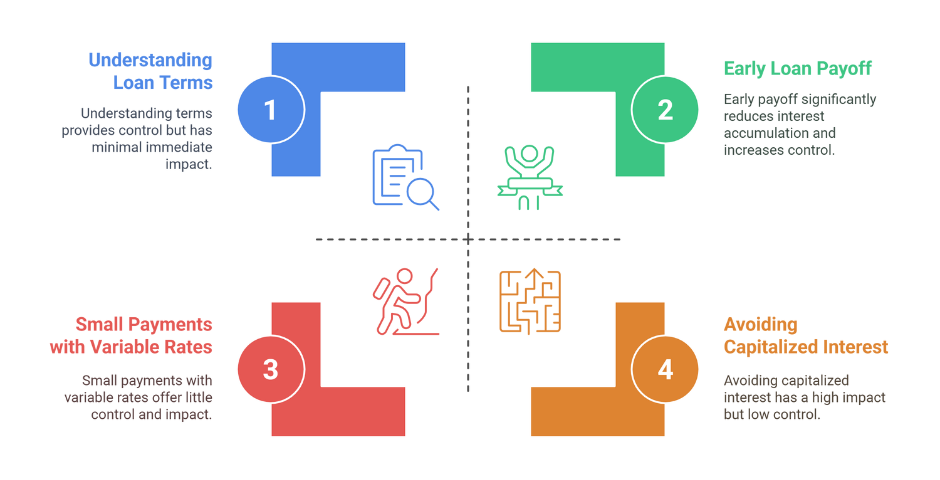Have you ever checked your loan account and noticed that your balance is higher than before—even though you’re making payments? You’re not alone. Many people are surprised to see their loan balance grow over time instead of shrink. But don’t worry: this guide will help you understand what’s increasing your loan balance and give you smart, simple steps to stop it from getting worse.
Whether it’s a student loan, personal loan, or even a car loan, knowing how loan balances work is essential for your financial health. Let’s dive into the common reasons behind the growing numbers—and what you can do to stay in control.
1. Interest accrual: the silent balance builder
One of the most common reasons your loan balance increases is interest accrual. This means interest is building up daily—even if you’re not making payments.
Why it happens:
- Loans often charge daily interest.
- If you’re in a grace period, deferment, or forbearance, interest might still be piling up.
- When interest is not paid, it doesn’t just sit there—it can be capitalized (added to your principal), making your future interest charges even higher.
How to avoid it:
- If possible, make small interest-only payments during grace or deferment periods.
- Consider loans with simple interest (not compounding daily).
- Pay more than the minimum when you can—extra payments can go toward reducing interest and principal.
2. Late payments and penalties
Missing a payment or paying late can hurt more than just your credit—it can increase your balance.
Why it happens:
- Lenders may charge late fees.
- Unpaid interest might be capitalized.
- Repeated late payments can lead to default, which may trigger collection costs and legal fees.
How to avoid it:
- Set up automatic payments to avoid missing due dates.
- Always check your payment due dates and calendar reminders.
- If you’re struggling, reach out to your lender for a revised payment plan before you miss a payment.
3. Loan capitalization: when interest joins the party
Capitalization means that your unpaid interest becomes part of your loan’s total balance. It’s like your loan is growing from the inside out.
Why it happens:
- Common with student loans when you leave school, exit a deferment period, or enter repayment after forbearance.
- Also possible with debt restructuring or loan modification.
How to avoid it:
- Try to pay off the interest before it capitalizes.
- Understand your loan terms—ask your lender when and how interest might be capitalized.
- Choose loan options that limit or prevent capitalization.
4. Variable interest rates: unexpected surprises
Some loans come with variable interest rates, which means your interest rate can go up depending on the market.
Why it happens:
- Your loan agreement allows changes based on external benchmarks.
- Over time, a higher interest rate means more daily interest charges, increasing your balance.
How to avoid it:
- If possible, choose fixed-rate loans for predictable payments.
- If you already have a variable-rate loan, monitor rate changes and consider refinancing when rates are low.
5. Negative amortization: paying less than you owe
This happens when your monthly payment is not enough to cover the interest that’s due, causing unpaid interest to build up.
Why it happens:
- You’re on a reduced payment plan or income-driven repayment plan.
- Your lender allows low monthly payments but doesn’t cover full interest.
How to avoid it:
- Pay more than the minimum whenever you can.
- Revisit your repayment plan annually to adjust based on income.
- Explore loan forgiveness programs if available after a certain repayment period.
6. Loan fees and other charges
Some lenders charge origination fees, processing fees, or maintenance charges that get added to your balance.
Why it happens:
- Hidden or unclear fees built into the loan terms.
- Failure to meet loan conditions or use certain services might trigger extra costs.
How to avoid it:
- Read your loan agreement carefully before signing.
- Ask your lender to explain any fees you don’t understand.
- Avoid unnecessary services or features that carry additional costs.
Take back control of your loan
Watching your loan balance grow despite your efforts can be frustrating—but it doesn’t have to stay that way. By understanding what’s increasing your loan balance, you’re already on the path to taking control.
Here’s a quick recap:

Stay informed, stay consistent, and don’t let your loan balance grow behind your back.

